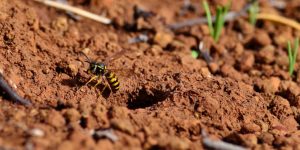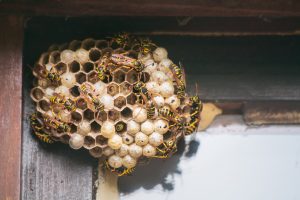You will find two kinds of wasps you should know about: the social wasp and the solitary wasp. Unless you’re allergic to wasps, you do not need to worry too much about what is known as the solitary wasp, the lonely hunter that just targets a single type of quarry (not people!)
The social wasp is the kind of wasp you should consider. Such a wasp is entirely dangerous in the sense and incredibly competitive that it does not differentiate between its extensive quarry and you. Social wasps sting on clue they perceive a risk. You’ll understand about it if you get too close if you happen upon a social wasp.
Recognising the wasp from the bee, the stinger of a wasp, unlike a bee, will not break off during the sting, which means they can several times sting you over; you can be stung by a bee once and it will lose its stinger.

Wasps also present a difficulty depending on how and where they can nest. Some species of wasps can nest underneath leaves on the earth or in clumps of moss. Some nest in trees. Airborne colonies are usually smaller than those who underground. Subterranean colonies can grow in readymade holes, like rodent holes or old snake holes. You might discover nests under the edge of your roof, in your garage or porch ceiling, in your old automobile, underground at the corner of your window.

Luckily, all wasps eliminate when temperatures get below freezing except the Queen that is fertilized. The Queen hibernates until the springtime when it then goes off to begin a brand new colony. For an individual wasp flying about, if you often have wasp issues in your house, you should be on the lookout out in the springtime. More likely than not, especially in early spring, this wasp is not unlikely to function as queen. If possible, it should be killed by you. Every springtime the Queen wasp begins a young colony.
Differentiate them for instance and to identify wasps, you should consider the yellow and black ringed insects thin and cylindrical legs, with especially narrow waists, and, maybe most notably, a smooth, nearly glistening skin.
Differentiating from wasps, most species of bees are rounded and more stable around their midsections, especially inside their bodies. In addition, they are usually hairy; they’re more dangerous than wasps. Hind legs additionally are generally flattened since they’re designed for transfer and the collection of pollen.
Wasps have some worth in the sense they feed on insects, including flies, caterpillars, crickets, and other pests during the springtime and early summer. Insects constitute the principle diet of the recently hatched wasps, the young appearing from the eggs that are laid.
All wasps are predators and it’s also vital that you remember this as you set about coping together as a pest issue. By the end of summer time, the Queen stops laying nests and eggs begin to fall. The eating habits of wasps shift at the same time. The precedence becomes the set of sweet foods (carbs). Most wasps start to scavenge food vigorously from people, becoming a permanent fixture at many locations where beverages or food are served outside.